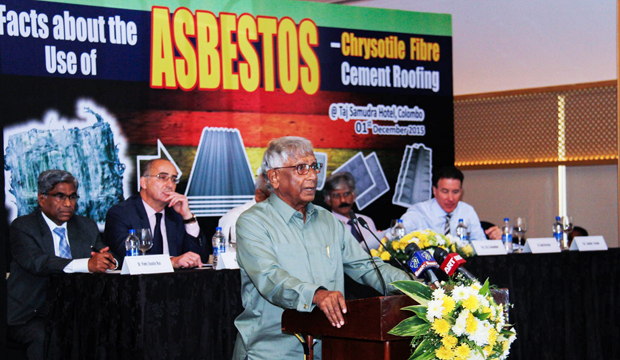December, 5, 2015

The Chamber of Construction Industry Sri Lanka (CCI), the apex body which represents all the construction industry stakeholders in Sri Lanka held a special seminar on “Facts about the use of ASBESTOS – Chrysotile Cement Roofing” at the Taj Samudra Hotel. Taking in to consideration the call to ban all asbestos related products in Sri Lanka, the CCI as the responsible main representative of the construction industry brought together both international and local experts to discuss various aspects pertaining to the issue.
The event was supported by the Chrysotile Information Centre. The Chrysotile Information Center is a non-profit organization established to provide scientific information, public education and assistance in relation to the responsible and safe use of Chrysotile. It provides objective information, trainings and seminars to workers, manufacturers, members of the public, governments and other relevant stakeholders regarding best practices for Chrysotile fiber handling and usage. The center also advocates for the mandatory inclusion of safe use programs, and works closely with local manufacturers and relevant government/regulatory bodies to raise awareness about the need for and benefits of safe use. It has presence in Thailand, Malaysia, Vietnam, Laos, Cambodia, the Philippines, Sri Lanka and Pakistan.
Speaking on the decision to hold the seminar, Secretary General/Chief Executive Officer of the CCI Eng. Nissanka N. Wijeratne notes, “As the representative of the construction industry in Sri Lanka the CCI is concerned about the adverse effects a blanket ban of asbestos related products could have on our industry stakeholders without a proper evaluation on the health and economic impacts. Therefore we are bringing together internationally renowned experts together with the experts in Sri Lanka to carefully evaluate all aspects of asbestos usage, safety measures and alternatives etc. both internationally and locally. We are indeed privileged to have several renowned speakers at our seminar at which we hope to shed significant light on the usage of Chrysotile asbestos, Sri Lanka’s position and a scientific study of risks vs. economic use.”
Dr. David M Bernstein Ph.D. a world renowned toxicologist will deliver a comprehensive address on “Health risks of Chrysotile revisited”. Dr. Bernstein has over 35 years of experience in the conduct of inhalation toxicology studies with pharmaceuticals and chemicals and in the evaluation of their toxicological effects. Meanwhile the legal advisor of the International Chrysotile Association Emiliano Alonso will discuss the “WHA/WHO’s position on Chrysotile”. During the second session of the seminar, Dr. Vivek Chandra Rao a senior medical professional from India will bring facts and figures from closer to home in his speech on “The current regulations and situation in India”. The final topic of discussion of the seminar will be “Alternatives to Chrysotile Cement Roofing” which will be presented by Professor S.M.A. Nanayakkara, Professor of Civil Engineering at the University of Moratuwa.
Understanding of the health risk from Chrysotile Asbestos as used today in high density cement products
Chrysotile
Amphiboles
Why do some fibers cause disease?
What does toxicology say about these two minerals?
Proposed Substitutes
Conclusions
provides strong support that Chrysotile is significantly less hazardous than the amphibole forms of asbestos (e.g. crocidolite and amosite).
Video Story